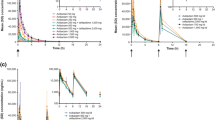Summary
Cefroxadine and cephalexin were compared in a double-blind study in patients with established, complicated urinary tract infections. The patients were treated orally with 1 g t.i.d. for five days. Bacterial counts in the urine were determined one, three and eight hours after the first dose and on the second, third and fifth days of treatment. A significant reduction in the bacterial count was seen one and three hours after the first dose and to a much greater extent eight hours after the dose. Reductions in the bacterial count were more frequent in the group treated with cefroxadine. The results during the first eight hours indicate that cefroxadine kills more rapidly than cephalexin; this is in agreement with the experimental findings. It is still uncertain whether the transient differences observed in the rates of inhibition are of clinical relevance.
Zusammenfassung
Bei Patienten mit nachgewiesener, komplizierter Harnwegsinfektion wurden Cefroxadin und Cephalexin in einer Doppelblindstudie miteinander verglichen. Die Patienten erhielten dreimal täglich 1 g per os, fünf Tage lang. Die Keimzahlen im Urin wurden eine, drei und acht Stunden nach der ersten Dosis und am zweiten, dritten und fünften Behandlungstag bestimmt. Eine eindeutige Reduktion der Keimzahlen war bereits eine und drei Stunden nach der ersten Dosis festzustellen sowie, in viel größerem Ausmaß, nach acht Stunden. Der Rückgang der Keimzahl war in der mit Cefroxadin behandelten Gruppe häufiger. Die Resultate innerhalb der ersten acht Stunden besagen, daß Cefroxadin rascher bakterizid wirkt als Cephalexin, was mit den experimentellen Befunden im Einklang steht. Ob die beobachteten, vorübergehenden Unterschiede im Ansprechen auf die beiden Präparate klinisch von Bedeutung sind, bleibt ungewiß.
Similar content being viewed by others
Literature
Hunter, P. A., Rolinson, G. N., Witting, D. A. Comparative activity of amoxycillin and ampicillin in an experimental bacterial infection in mice. Antimicrob. Agents Chemother. 4 (1973) 285–293.
Rolinson, G. N., Macdonald, A. C., Wilson, D. A. Bactericidal action of β-lactam antibiotics onEscherichia coli with particular reference to ampicillin and amoxycillin. J. Antimicrob. Chemother. 3 (1977) 541–553.
Comber, K. R., Boon, R. J., Sutherland, R. Comparative effects of amoxycillin and ampicillin on the morphology ofEscherichia coli in vivo and correlation with activity. Antimicrob. Agents Chemother. 12 (1977) 736–744.
Zak, O., Vischer, W. A., Schenk, C., Tosch, W., Zimmermann, W., Regös, J., Suter, E. R., Kradolfer, F., Gelzer, J. CGP 9000: A new orally active, broad-spectrum cephalosporin. J. Antibiot. 29 (1976) 653–655.
Zak, O., Tosch, W., Vischer, W. A., Kradolfer, F. Comparative experimental studies on 3-methoxy and 3-methyl cephems. Drugs Exp. Clin. Res. 3 (1977) 11–20.
Vischer, W. A., Zak, O., Konopka, E. A., Fehimann, H., Regös, J., Tosch, W.: Experimental evaluation of CGP 9000, a new orally active cephalosporin. Curr. Chemother. (1978) 825–827.
Cowan, S. T., Steel, K. J. Manual for the identification of medical bacteria. 2nd ed. Revised byCowan, S. T., Cambridge University Press, London 1974.
Ericsson, H. M., Sherris, J. C. Antibiotic sensitivity testing. Acta. Pathol. Microbiol. Scand. Section B 79B Suppl. 217 (1971) 1–90.
Steers, E., Foltz, E. L., Graves, B. S. An inocula replicating apparatus for routine testing of bacterial susceptibility to antibiotics. Antibiot. Chemother. 9 (1959) 307–311.
Waisbren, B. A. The proof of efficacy of antibiotics. Am. J. Med. Sci. 250 (1965) 406–423.
Acar, J. F. Dynamique de la bactériurie dans les infections urinaires à bacilles gram négatifs traîtées par les antibiotiques. Pathol. Biol. 17 (1969) 859–864.
Naber, K., Ahrens, T., Zimmermann, W., Puppel, H., Schultheiss, H., Maly, V. Klinische Bedeutung der β-Laktamase-Produktion von Bakterien bei der Therapie der Harnwegsinfektionen mit oralen β-Laktam-Antibiotika. Urologe A 21 (1982) 225–228.
Author information
Authors and Affiliations
Rights and permissions
About this article
Cite this article
Ahrens, T., Naber, K.G. Activity of cefroxadine and cephalexin in urinary tract infections: A double-blind comparative study. Infection 11, 25–30 (1983). https://doi.org/10.1007/BF01651353
Received:
Accepted:
Issue Date:
DOI: https://doi.org/10.1007/BF01651353




